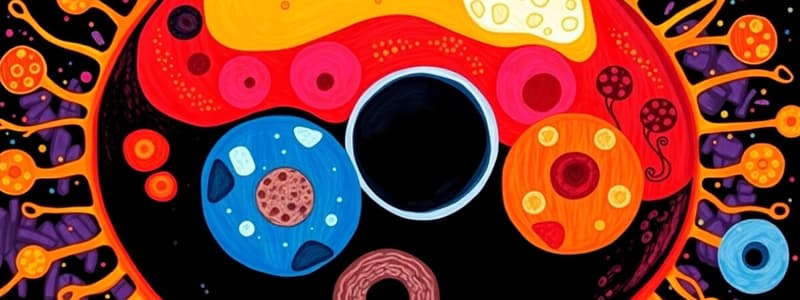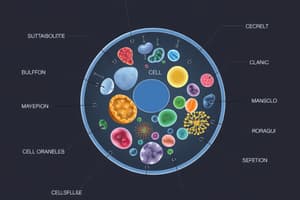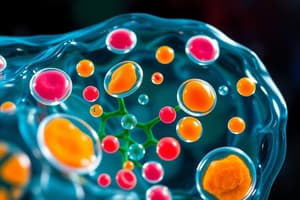Podcast
Questions and Answers
Which organelle is responsible for producing proteins?
Which organelle is responsible for producing proteins?
- Vacuole
- Lysosome
- Nucleus
- Ribosomes (correct)
All cells come from pre-existing cells is a main idea of the cell theory.
All cells come from pre-existing cells is a main idea of the cell theory.
True (A)
What process does an amoeba use to ingest large food particles?
What process does an amoeba use to ingest large food particles?
endocytosis
In a __________ environment, the concentration of dissolved substances is greater outside the cell than inside the cell.
In a __________ environment, the concentration of dissolved substances is greater outside the cell than inside the cell.
Which structure is uniquely found in the rough endoplasmic reticulum but absent in the smooth endoplasmic reticulum?
Which structure is uniquely found in the rough endoplasmic reticulum but absent in the smooth endoplasmic reticulum?
What type of microscope provides a two-dimensional image of the interior of a specimen?
What type of microscope provides a two-dimensional image of the interior of a specimen?
Match the organelles/functions with their correct descriptions:
Match the organelles/functions with their correct descriptions:
Where are the tails of a phospholipid molecule located?
Where are the tails of a phospholipid molecule located?
What is the primary role of transpiration in plants?
What is the primary role of transpiration in plants?
Root hairs are responsible for carbon dioxide uptake.
Root hairs are responsible for carbon dioxide uptake.
What process can move molecules against a concentration gradient?
What process can move molecules against a concentration gradient?
Gas exchange occurs at _______.
Gas exchange occurs at _______.
Match the following biomes with their characteristics:
Match the following biomes with their characteristics:
Which statement is correct regarding gravitropism?
Which statement is correct regarding gravitropism?
Photosynthesis is the process that adds carbon dioxide to the atmosphere.
Photosynthesis is the process that adds carbon dioxide to the atmosphere.
What kind of trees are found in the taiga biome?
What kind of trees are found in the taiga biome?
The liquid in the phloem primarily contains _______.
The liquid in the phloem primarily contains _______.
What is a common effect of deforestation?
What is a common effect of deforestation?
The climate zone found in Canada includes tropical regions.
The climate zone found in Canada includes tropical regions.
What do spongy tissue cells in leaves primarily allow for?
What do spongy tissue cells in leaves primarily allow for?
The process of removing carbon dioxide from the atmosphere is called _______.
The process of removing carbon dioxide from the atmosphere is called _______.
Match the scientists with their contributions to cell theory:
Match the scientists with their contributions to cell theory:
What is the primary function of guard cells in a leaf?
What is the primary function of guard cells in a leaf?
Photosynthesis occurs in the mitochondria of plant cells.
Photosynthesis occurs in the mitochondria of plant cells.
What process allows the movement of water across a cell membrane?
What process allows the movement of water across a cell membrane?
In a __________ solution, the concentration of solutes is lower inside the cell than outside, causing the cell to shrink.
In a __________ solution, the concentration of solutes is lower inside the cell than outside, causing the cell to shrink.
Match the following plant tissues with their functions:
Match the following plant tissues with their functions:
What is the main purpose of exocytosis in a cell?
What is the main purpose of exocytosis in a cell?
Diffusion is faster over short distances than long distances.
Diffusion is faster over short distances than long distances.
What role does xylem play in plants?
What role does xylem play in plants?
What describes the movement of water in an isotonic solution?
What describes the movement of water in an isotonic solution?
Cohesion refers to the attraction of water molecules to other substances.
Cohesion refers to the attraction of water molecules to other substances.
What are root hairs primarily responsible for?
What are root hairs primarily responsible for?
During transpiration, water is lost by __________ to help maintain turgor pressure.
During transpiration, water is lost by __________ to help maintain turgor pressure.
Match the following terms with their definitions:
Match the following terms with their definitions:
Which process allows sugars to move downwards through the plant?
Which process allows sugars to move downwards through the plant?
Stomata close to conserve water when guard cells lose turgor pressure.
Stomata close to conserve water when guard cells lose turgor pressure.
What is root pressure?
What is root pressure?
What is the function of the diaphragm in a microscope?
What is the function of the diaphragm in a microscope?
All organisms are made up of a single cell according to cell theory.
All organisms are made up of a single cell according to cell theory.
Who first observed single-celled organisms and named them animalcules?
Who first observed single-celled organisms and named them animalcules?
The __________ adjustment moves the stage up or down to focus on the object under low power.
The __________ adjustment moves the stage up or down to focus on the object under low power.
Which scientist's experiment involved two jars of meat to disprove abiogenesis?
Which scientist's experiment involved two jars of meat to disprove abiogenesis?
Match the following scientists with their contributions to cell theory:
Match the following scientists with their contributions to cell theory:
Biogenesis is the idea that life can emerge from non-living matter.
Biogenesis is the idea that life can emerge from non-living matter.
What are three key points of cell theory?
What are three key points of cell theory?
What is the primary function of lysosomes within a cell?
What is the primary function of lysosomes within a cell?
The cell membrane is made up of a phospholipid monolayer.
The cell membrane is made up of a phospholipid monolayer.
What role do mitochondria play in the cell?
What role do mitochondria play in the cell?
Animal cells typically have many small ________ while plant cells have one large ________.
Animal cells typically have many small ________ while plant cells have one large ________.
Match the following organelle with its primary function:
Match the following organelle with its primary function:
Which of the following statements is true about prokaryotic cells?
Which of the following statements is true about prokaryotic cells?
Channel proteins are responsible for transporting large molecules across the cell membrane.
Channel proteins are responsible for transporting large molecules across the cell membrane.
What is the main role of the cell membrane?
What is the main role of the cell membrane?
Flashcards
What organelle produces proteins?
What organelle produces proteins?
Ribosomes are the cellular organelles responsible for protein synthesis.
What kind of environment occurs when the concentration of dissolved substances is greater outside the cell than inside the cell?
What kind of environment occurs when the concentration of dissolved substances is greater outside the cell than inside the cell?
A hypertonic environment occurs when the concentration of dissolved substances outside the cell is higher than inside the cell.
An amoeba ingests large food particles by ...
An amoeba ingests large food particles by ...
Endocytosis is the process by which cells engulf large particles or substances from their environment.
What is a main idea of the cell theory?
What is a main idea of the cell theory?
Signup and view all the flashcards
A two-dimensional image of the interior of a specimen can be viewed with a ...
A two-dimensional image of the interior of a specimen can be viewed with a ...
Signup and view all the flashcards
Which structure is found in rough endoplasmic reticulum but not in smooth endoplasmic reticulum?
Which structure is found in rough endoplasmic reticulum but not in smooth endoplasmic reticulum?
Signup and view all the flashcards
The small size of cells is best correlated with ...
The small size of cells is best correlated with ...
Signup and view all the flashcards
Vesicles from the smooth endoplasmic reticulum are most likely on their way to the ...
Vesicles from the smooth endoplasmic reticulum are most likely on their way to the ...
Signup and view all the flashcards
Transpiration
Transpiration
Signup and view all the flashcards
Transpiration pull
Transpiration pull
Signup and view all the flashcards
Root hairs
Root hairs
Signup and view all the flashcards
Gravitropism
Gravitropism
Signup and view all the flashcards
Diffusion
Diffusion
Signup and view all the flashcards
Active transport
Active transport
Signup and view all the flashcards
Gas exchange in plants
Gas exchange in plants
Signup and view all the flashcards
Sucrose
Sucrose
Signup and view all the flashcards
Turgor pressure
Turgor pressure
Signup and view all the flashcards
Theodor Schwann's contribution to cell theory
Theodor Schwann's contribution to cell theory
Signup and view all the flashcards
Rudolf Virchow's contribution to cell theory
Rudolf Virchow's contribution to cell theory
Signup and view all the flashcards
Anton van Leeuwenhoek's contribution to cell theory
Anton van Leeuwenhoek's contribution to cell theory
Signup and view all the flashcards
Leaf epidermis
Leaf epidermis
Signup and view all the flashcards
Spongy tissue cells
Spongy tissue cells
Signup and view all the flashcards
Taiga
Taiga
Signup and view all the flashcards
Biogenesis
Biogenesis
Signup and view all the flashcards
Revolving nosepiece
Revolving nosepiece
Signup and view all the flashcards
Endocytosis
Endocytosis
Signup and view all the flashcards
Electron microscope
Electron microscope
Signup and view all the flashcards
Compound Light Microscope (CLM)
Compound Light Microscope (CLM)
Signup and view all the flashcards
Abiogenesis
Abiogenesis
Signup and view all the flashcards
Cell
Cell
Signup and view all the flashcards
Cell theory
Cell theory
Signup and view all the flashcards
What is a cell?
What is a cell?
Signup and view all the flashcards
What are eukaryotes?
What are eukaryotes?
Signup and view all the flashcards
What are prokaryotes?
What are prokaryotes?
Signup and view all the flashcards
What is the nucleus?
What is the nucleus?
Signup and view all the flashcards
What is the cell membrane?
What is the cell membrane?
Signup and view all the flashcards
What is cellular respiration?
What is cellular respiration?
Signup and view all the flashcards
What is a phospholipid bilayer?
What is a phospholipid bilayer?
Signup and view all the flashcards
What are integral proteins?
What are integral proteins?
Signup and view all the flashcards
Phagocytosis
Phagocytosis
Signup and view all the flashcards
Pinocytosis
Pinocytosis
Signup and view all the flashcards
Tonicity
Tonicity
Signup and view all the flashcards
Osmosis
Osmosis
Signup and view all the flashcards
Hypotonic solution
Hypotonic solution
Signup and view all the flashcards
Hypertonic solution
Hypertonic solution
Signup and view all the flashcards
Isotonic
Isotonic
Signup and view all the flashcards
Tonicity Relationship
Tonicity Relationship
Signup and view all the flashcards
Adhesion
Adhesion
Signup and view all the flashcards
Cohesion
Cohesion
Signup and view all the flashcards
Capillary action
Capillary action
Signup and view all the flashcards
Xylem sap
Xylem sap
Signup and view all the flashcards
Xylem vessels
Xylem vessels
Signup and view all the flashcards
Root pressure
Root pressure
Signup and view all the flashcards
Study Notes
Organelle Function
- Ribosomes produce proteins.
Cell Environment
- A hypertonic environment has a higher concentration of dissolved substances outside the cell than inside.
Amoeba Ingestion
- Amoebas ingest large food particles through endocytosis.
Cell Theory
- All cells come from pre-existing cells.
Microscopy
- A compound light microscope creates a two-dimensional image of a specimen's interior.
Endoplasmic Reticulum
- Ribosomes are found on rough endoplasmic reticulum, but not smooth endoplasmic reticulum.
Cell Size
- Cell size is correlated with adequate surface area for material exchange.
Vesicle Destination
- Vesicles from smooth endoplasmic reticulum move to the Golgi apparatus.
Lysosome Function
- Lysosomes are involved in intracellular digestion.
Membrane Structure
- The fluid-mosaic model describes the fluidity of proteins and phospholipids in the membrane.
Phospholipid Structure
- The tails of a phospholipid molecule are located in the interior of the membrane.
Stomata Opening
- Stomata usually open during the day, aiding carbon dioxide uptake.
Transpiration and Water Transport
- Transpiration creates tension that pulls water up vessel elements.
Root Hair Function
- Root hairs are involved in water and mineral uptake, but not in oxygen or carbon dioxide uptake.
Plant Growth Response
- Both stems and roots show positive gravitropism (growth towards gravity).
Active Transport
- Active transport moves molecules against a concentration gradient.
Lenticels
- Lenticels facilitate gas exchange.
Phloem Liquid
- The liquid in phloem primarily contains sucrose.
Plant Turgor Pressure
- Adding water to the soil increases turgor pressure in plants.
Cell Theory Scientists
- Theodor Schwann: Proposed that all plants are composed of cells.
- Rudolf Virchow: Proposed that all cells come from pre-existing cells.
- Anton van Leeuwenhoek: Primarily known for his observations of microorganisms.
Leaf Epidermis
- The epidermis protects the leaf. Its waxy cuticle prevents water loss.
Spongy Tissue Cells
- Spongy tissue cells help with gas exchange (CO2 intake and O2 release). Their loose arrangement provides a large surface area.
Canadian Climate Zones
- Canada has temperate and polar climate zones.
Biome Representation
- Specific details regarding the climatographs were not included.
Biome Characteristics
- Taiga: Coniferous trees, animals hibernate.
- Tropical Rain Forest: High biodiversity.
- Desert: Low biodiversity.
Adaptations
- Structural adaptations involve physical features (e.g., large ears for heat dissipation in a desert rat).
Climate Change
- The enhanced greenhouse effect is not a natural event (it's human caused).
Carbon Cycle
- Photosynthesis removes carbon dioxide from the atmosphere.
Deforestation Impacts
- Deforestation causes increased atmospheric CO2, decreased biodiversity, and altered surface albedo.
Studying That Suits You
Use AI to generate personalized quizzes and flashcards to suit your learning preferences.




